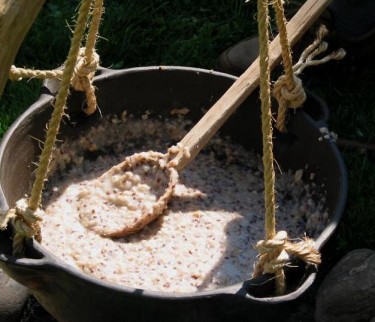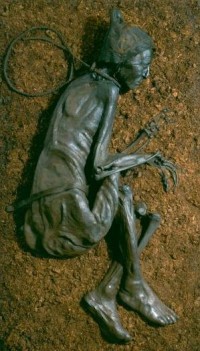How To Make Bogman's Weedseed Gruel (Without Being A Bogman)
How To Make Bogman’s Weedseed Gruel (Without Being A Bogman)
by Raynor Ganan

What’s the oldest recipe you know? Is it your grandmother’s top-secret ingredients list for johnnycakes? Perhaps you collect cookbooks and can point to a delightful “fricassée of sheep trotters” in your prized 18th-century housewife manual. You might even know about the marvelous medieval cookery website and are tempted by its zervelats(sausages stuffed with bacon and cheese) or chardewardon (pear custard). Because of the written word, a preservative even more potent than pickle brine, we know what Julius Caesar ate for dinner 2000 years ago1 and a formula for cake bread that appears in the Bible2. But not all cultures have had writing, which means that many of history’s greatest dishes have been lost to time. But maybe not! Through a collaboration across disciplines, historians and scientists are able to reconstruct millennium-old recipes for our tasting pleasure. This is the story of an Iron Age bogman, what he ate for his last meal a thousand years ago, and how, with a little resourceful gathering, you can make it for dinner tonight.
In the late Danish spring in 1950, as hyacinths yielded to tulips and the days grew increasingly longer, Viggo Højgaard and his brother Emil began digging a hole in the local bog in search of peat to fuel their cooking stove. They cut through the mud as they always had, collected the peat as they always had, and loaded a sizable swath in their cart as they always had. But then Viggo’s wife wandered by and spotted something that none of them ever had — an umber brown foot attached to a sinewy, naked thigh sticking out of the sod. The Højgaard brothers had stumbled upon a body, but not just any body, they had discovered the body of a remarkably preserved man from the 4th-century BC.

As Martin Jones writes in Feast, the conditions of the Bjældskovdal Bog were ideal for natural mummification. The acid level was just high enough to tan and toughen the bogman’s soft tissue but not so high so as to completely dissolve it. There was also a scarcity of oxygen and the bog moss’s uncanny ability to leach away all nutrients — both necessary provisions of decay organisms. The 2000-year-old bogman had casually escaped the shipwreck of time. The Danish anthropologist P.V. Glob writes in (the thoroughly engrossing) The Bog People, how well preserved Tollund Man was. His face was so tranquil it seemed he might have died while dreaming of sunshine and frolicking woodland creatures. His skin was so well protected that forensic investigators could take his fingerprints; and his stomach contents had decayed so little that scientists could establish, down to the smallest crumb, what he ate for his last supper.
Through modern paleo-CSI analyses, investigators were able to determine the source of the water Tollund Man drank (one abundant with sphagnum moss), what the fire that heated his food was fueled with (heather), and even how hot it was when it finished cooking (98°, like my second-favorite boy band).
But more interesting was what they learned about his eating habits. For starters, no trace of animal flesh could be found amongst the bogman’s stomach contents — his last meal was entirely vegetarian. Even more peculiar, there were no green vegetables to be found — everything in his gut was either seed or grain. And not just any seeds or grains, his last meal was very probably a gruel made with over 40 varieties of weedseeds, dense chaff, low-yield grass cereals, and hard-to-harvest runt grains. There’s nothing wrong with eating weedseeds per se; in fact some of the seeds were wild relatives of buckwheat and quinoa. However, as Richard Mabey writes in Weeds, the bother of gathering weedseeds as a food would hardly be worthwhile — it can take more energy to collect them than one can recover in consuming them.
Astonishingly, our bogman’s grain binge is consistent with the gruel diets of other recently unearthed bog bodies like Lindow Man, Grauballe Man, Windeby girl and dozens more. To ratchet up the intrigue, it now seems that all of these bog bodies were the victims of murder (the plot, like weedseed gruel itself, thickens). What’s the correlation between these ancient bodies and their diet? Were they victims of an Iron Age witch hunt for vegetarians? Were they sacrificed by their own people and given a ritualistic last meal rife with earthen seeds? Perhaps they were early advocates of biodiverse polycultures and perished before anyone could figure out how to make harvesting 40-plus unique seeds a viable alternative to hunting small game. Archaeologists are still debating, but one thing we do know is the approximate recipe of our bogman’s weedseed gruel. I have adapted this soon-to-be favorite family dish from an old Viking recipe and a Roman treatise on nature. Enjoy!
BOGMAN’S WEEDSEED GRUEL
— bog water: water infused with sphagnum moss works best • 10–15 cups
— cultivated grains:
pearl barley • 2 cups
wheat kernels (soak overnight) • 2 cups
flax • ¼ cup
willow herb seeds • ¼ cup
gold-of-pleasure seeds • ¼ cup
knotweed seeds (may cause photosensitivity) • ¼ cup
— with smaller amounts of:
fat hen (a relative of quinoa) seeds • ½ tsp
corn spurrey seeds • ½ tsp
black bindweed (a relative of buckwheat) seeds • ½ tsp
violet seeds • ½ tsp
hemp nettle seeds (potentially poisonous) • ½ tsp
mustard seeds • ½ tsp
dock seeds • ½ tsp
green bristle-grass (related to millet) seeds • ½ tsp
corn chamomile seeds • ½ tsp
redshank seeds • ½ tsp
greater plantain seeds • ½ tsp
clover seeds • ½ tsp
rye-grass seeds • ½ tsp
Yorkshire fog seeds • ½ tsp
buttercup seeds (may cause blistering of the skin) • ½ tsp
lady’s mantle seeds • ½ tsp
yarrow (may cause rashes) seeds • ½ tsp
smooth hawksbeard seeds • ½ tsp
fine sand3 • ½ tsp
1. Mix all ingredients into a bowl.
2. Stir.
3. Cook over fire (preferably one using heather as a fuel) for 1 hour, adding moss water as needed until gruel has reached desired consistency.
4. Salt4 to taste.
5. Trust no one.
While I have yet to make this gruel on my own5, in the golden age of British archaeology television (the 1950s), two prominent archeologists did. On the show “Buried Treasure,” Sir Mortimer Wheeler and Dr. Glyn Daniel tasted our bogman’s last supper. Sadly, this important footage doesn’t seem to be online, but in her book Wet Site Archaeology Barbara Purdy reports that the dish was rather oily and had a greyish-purple color, with flecks of orange and black throughout. Neither gentleman could stomach the porridge leading both to chase it with a rich Danish brandy from a cow-horn. The wry Mortimer commented to his companion that with porridge like that, perhaps the bogman had thrown himself into the bog.
1 Spoiler Alert: prickly globe-fish and swine udder patties.
2 A little water + a handful of meal + some oil et voilà! (1 Kings 17:12–13)
3 Only recently has the FDA started to acknowledge the benefits of eating sand. According to this questionable source, an enterprising chemistry student has invented the “Sand Bar,” an energy bar which is essentially “chocolate-covered beach.”
4 Salt was neither detected nor detectable in the bogman’s stomach, though Pliny mentions that the Germanic tribes did indeed salt their gruel.
5 Unsurprisingly, there is only one place on earth where all of these ingredients are found together and that place is in Denmark — bogman’s weedseed gruel is the epitome of the locally sourced movement.
Previously: What Does Elephant Taste Like?
Raynor Ganan is a mammal who spends time in the commonwealth of Massachusetts. He occasionally contributes to the ragbag, a component of the internet. Photos courtesy of The Tollund Man website.
